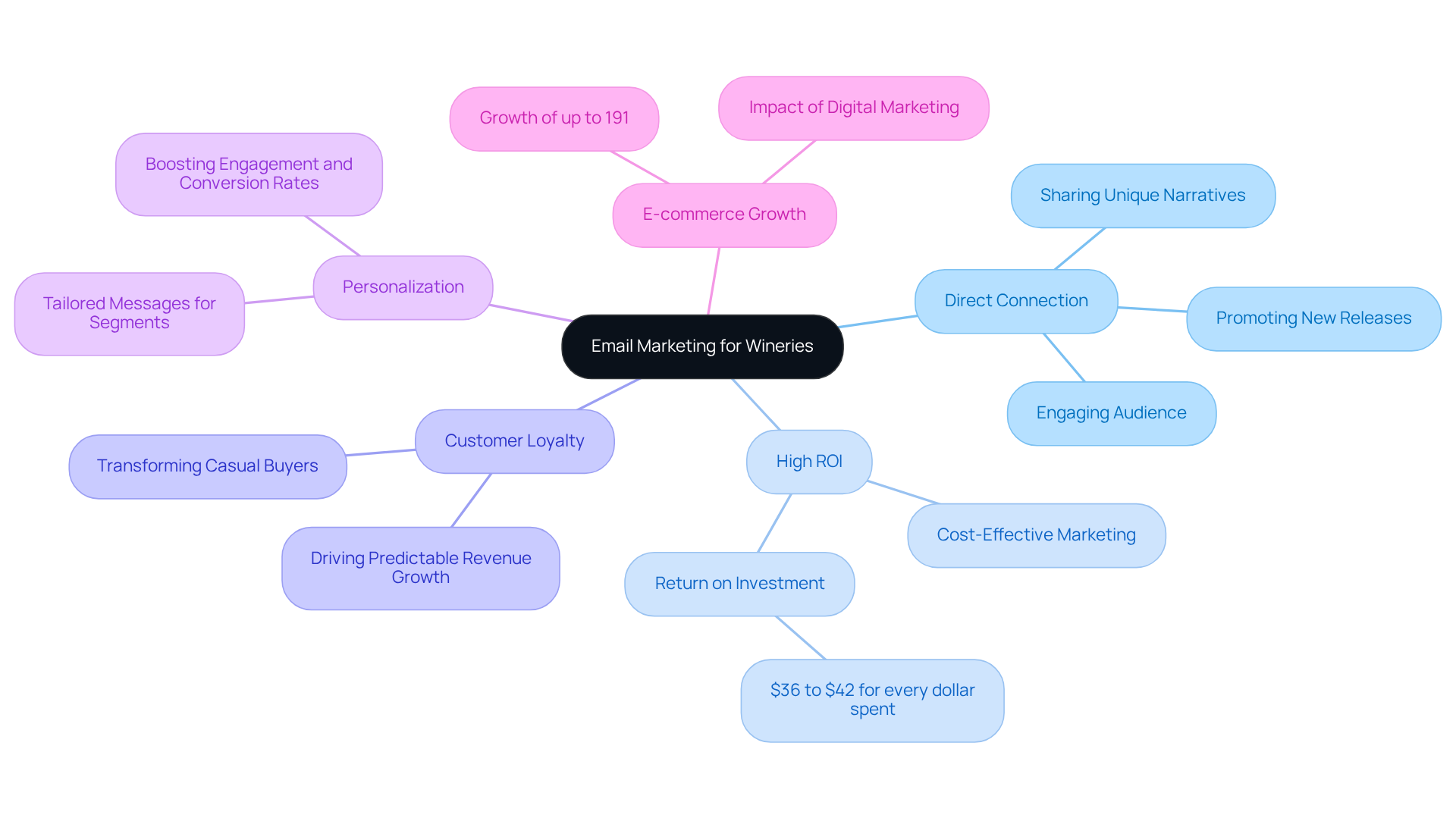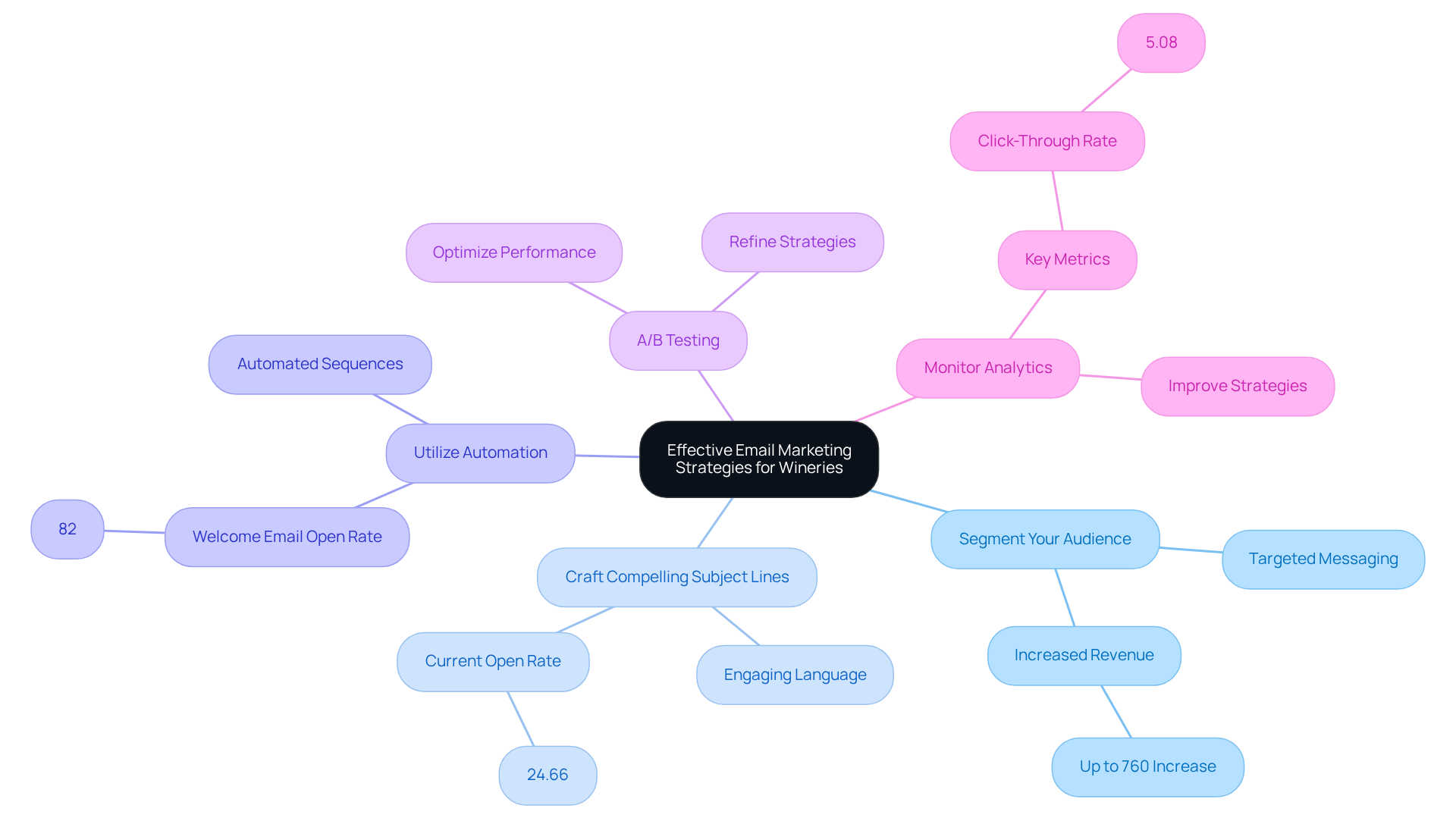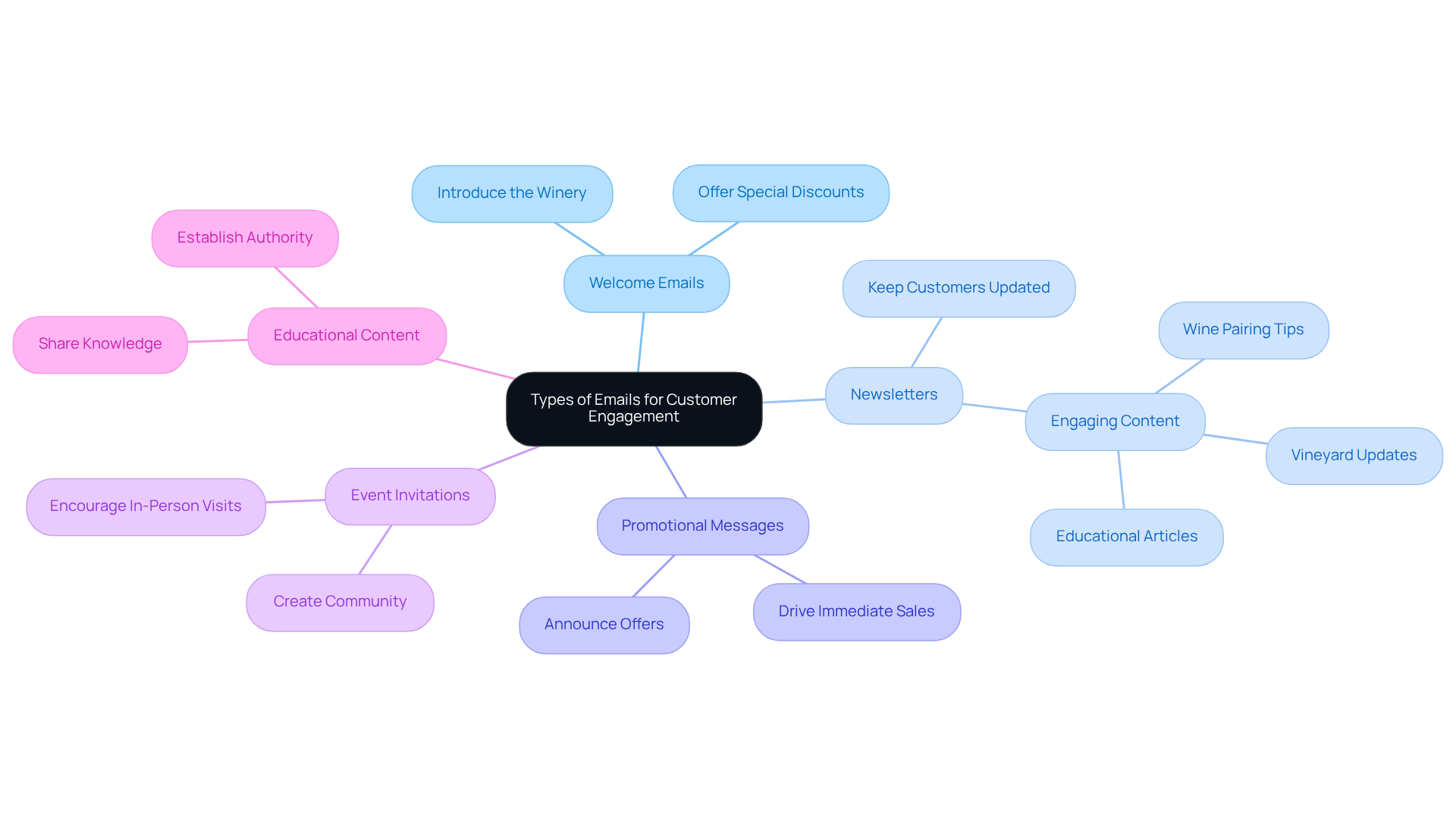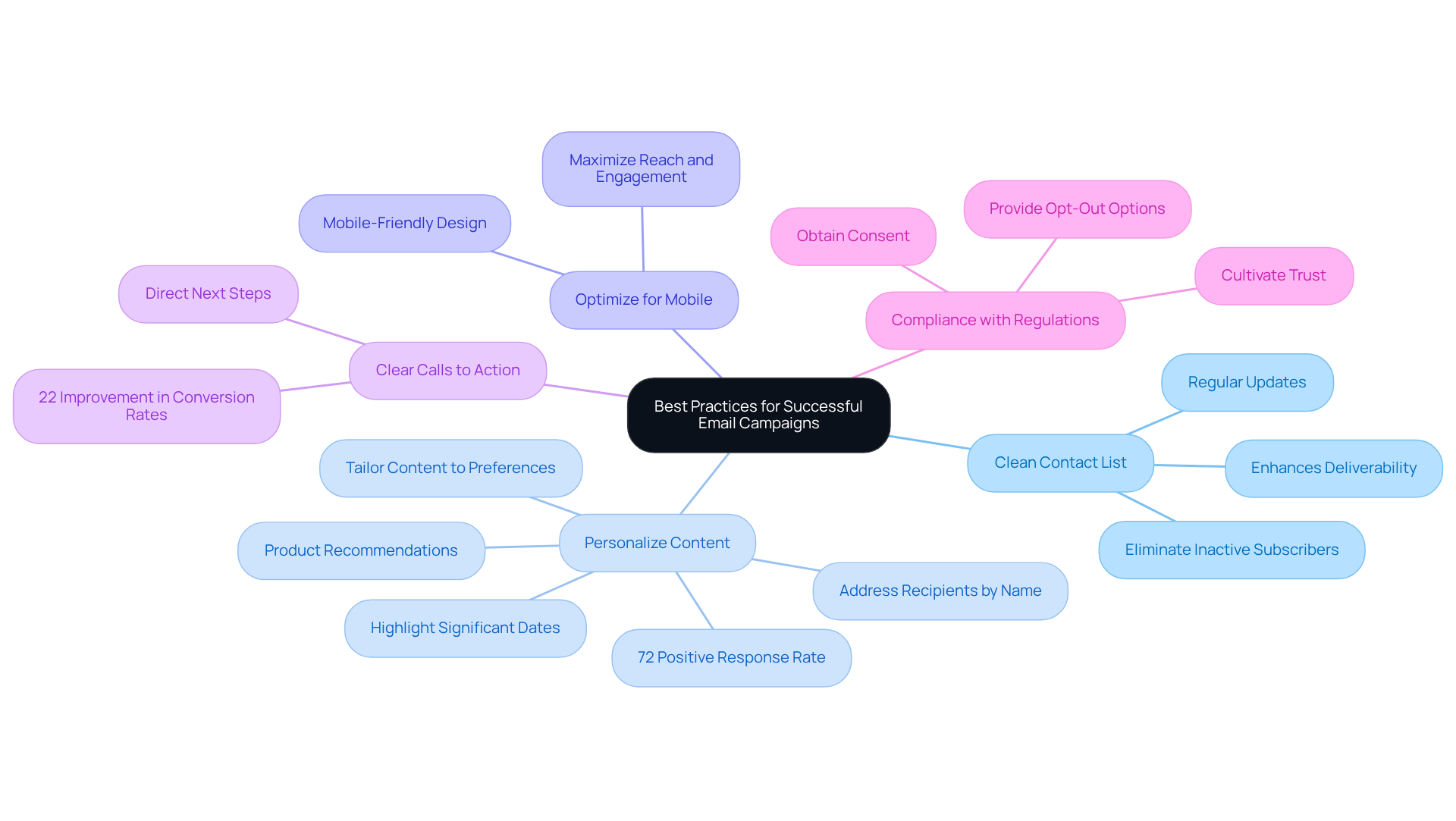Overview
Email marketing is essential for wineries, offering a direct and personal avenue to engage with customers, share compelling stories, and promote products. This approach not only fosters significant ROI but also cultivates customer loyalty. Effective strategies, such as:
- Audience segmentation
- Automation
- Personalized content
are crucial in enhancing engagement rates and driving e-commerce growth. These tactics illustrate the powerful impact of well-executed email campaigns within the wine industry. By implementing these strategies, wineries can effectively connect with their audience, addressing their needs and preferences while reinforcing their brand's presence in a competitive market.
Introduction
Email marketing has emerged as a vital lifeline for wineries, providing a direct channel to foster connections with customers and share their unique stories. By harnessing this powerful tool, wineries can promote new releases and cultivate loyalty, achieving remarkable returns on investment.
However, as the digital landscape evolves, how can wineries effectively navigate the complexities of email marketing to stand out in a crowded market? This article explores proven strategies that can transform email campaigns into a cornerstone of success, ensuring that vineyards not only reach but resonate with their audience.
Understand the Importance of Email Marketing for Wineries
Email marketing for wineries serves as a formidable tool, providing a direct and personal avenue to connect with customers. This approach allows vineyards to share their , promote new releases, and engage their audience in a meaningful way.
With a remarkable return on investment (ROI), digital marketing can yield between $36 to $42 for every dollar spent, establishing it as one of the most cost-effective marketing channels available today. Furthermore, it offers measurable outcomes, enabling vineyards to effectively monitor engagement and sales.
As the wine sector continues to evolve, the strategic use of electronic marketing becomes essential for maintaining a competitive edge and fostering client loyalty. By integrating digital correspondence marketing into comprehensive direct-to-consumer strategies—such as demand generation and wine club optimization—producers can transform casual buyers into devoted club members, thus enhancing customer retention and driving predictable revenue growth.
The capability for personalization at scale is also achievable through advanced tools, allowing producers to tailor their messages for various audience segments, which further boosts engagement and conversion rates. Notably, establishments that have embraced these strategies, particularly email marketing for wineries, have witnessed e-commerce growth of up to 191%, underscoring the significant impact of marketing through electronic correspondence in today’s digital landscape.

Implement Effective Email Marketing Strategies for Wineries
To implement effective email marketing strategies, wineries must prioritize the following key practices:
- Segment Your Audience: Begin by dividing your contact list into specific groups based on demographics, purchase history, and interaction levels. This targeted approach enables messaging that resonates with each segment, thereby enhancing engagement and conversion rates. Marketers utilizing segmented campaigns can witness revenue increases of up to 760%.
- Craft Compelling Subject Lines: The subject line serves as the initial impression of your message. Employ engaging and concise language to entice recipients to open your communications. Customized subject lines can significantly enhance open rates, with the current typical open rate for winery communications at 24.66%.
- Utilize Automation: Establish for welcome notifications, abandoned cart reminders, and follow-ups after purchases. Automation not only conserves time but also ensures prompt communication with clients, fostering stronger relationships. For instance, welcome messages boast an impressive open rate of 82%, which can enhance customer loyalty and support strategic capital planning.
- A/B Testing: Regularly assess various components of your messages, such as subject lines, content, and send times, to determine what resonates best with your audience. This practice refines your strategies and optimizes performance, leading to improved engagement and predictable DTC revenue.
- Monitor Analytics: Leverage analytics tools to track key metrics like open rates, click-through rates, and conversions. The typical click-through rate for vineyard correspondence is 5.08%. Tracking these metrics offers insights that can improve your strategies and boost upcoming campaigns. By concentrating on these methods, vineyards can effectively harness digital marketing to boost sales and enhance client loyalty.

Explore Types of Emails to Boost Customer Engagement
Wineries have a remarkable opportunity to elevate customer engagement by leveraging a variety of email types, including:
- Welcome Emails: A warm welcome message to new subscribers is essential. This email should introduce your establishment and offer a special discount on their first purchase, creating a positive first impression and fostering trust.
- Newsletters: Regular newsletters are vital for keeping customers informed about upcoming events, new releases, and winery news. Incorporate engaging content such as wine pairing tips, vineyard updates, and educational articles to enrich the subscriber experience. The average open rate for wine newsletters is around 31.3%, indicating strong engagement potential.
- Promotional Messages: Utilize promotional messages to announce , discounts, or limited-time promotions. These emails can incentivize purchases and drive immediate sales, capitalizing on the urgency of exclusive deals.
- Event Invitations: Inviting patrons to exclusive tastings, tours, or gatherings at your establishment fosters a sense of community and encourages in-person visits. This personal touch can significantly enhance client loyalty and engagement.
- Educational Content: Sharing informative material about wine production, tasting notes, and food pairings establishes your establishment as an authority in the industry. This not only enhances client loyalty but also enriches their wine knowledge, making them more likely to engage with your brand.
By applying these messaging strategies, vineyards can leverage email marketing for wineries to establish a strong communication structure that not only informs but also engages and retains clients.

Adopt Best Practices for Successful Email Campaigns
To ensure successful email campaigns, wineries must embrace essential best practices that will elevate their marketing efforts:
- Maintain a Clean Contact List: Regularly updating your contact list to eliminate inactive subscribers is vital. A tidy list not only enhances deliverability but also fosters higher interaction rates, as personalized communication resonates more effectively with an engaged audience.
- Personalize Content: Leverage customer information to customize messages by addressing recipients by name and tailoring content to their preferences and previous purchases. This approach has proven effective, with 72% of consumers responding positively to personalized content. Consider implementing various personalization tactics, such as recommending products based on past purchases or emphasizing significant dates like wine club sign-ups.
- Optimize for Mobile: Given that a substantial portion of users accesses messages via smartphones, ensuring that communications are mobile-friendly is crucial for maximizing reach and engagement.
- Include Clear Calls to Action (CTAs): Every message should feature a clear CTA that directs recipients on the next steps, whether it’s making a purchase, signing up for an event, or visiting your website. Personalized CTAs can result in a 22% improvement in conversion rates.
- Comply with Regulations: Adhering to marketing regulations, such as obtaining consent and providing a straightforward opt-out option, cultivates trust and sustains your establishment's reputation. This is especially critical in an environment where consumers are increasingly discerning about their interactions with brands.
By implementing these strategies, wineries can significantly enhance their marketing efforts, nurturing stronger relationships with customers and effectively driving e-commerce sales. Moreover, avoiding common missteps, such as ineffective audience segmentation, can further optimize campaign outcomes. Remember, email marketing transcends mere sales; it serves as a valuable opportunity to share your brand story and connect with your audience on a personal level.

Conclusion
Email marketing is a pivotal strategy for wineries aiming to connect with their audience and drive sales. By leveraging this direct communication channel, wineries can share their unique stories, promote new releases, and cultivate lasting relationships with customers. The potential for significant return on investment, coupled with the ability to measure engagement, underscores the necessity of integrating email marketing into a winery's broader marketing strategy.
Key insights reveal that effective email marketing hinges on understanding the audience, crafting engaging content, and utilizing automation and personalization. Strategies such as:
- Audience segmentation
- Compelling subject lines
- Regular analytics monitoring
can dramatically enhance engagement rates and customer loyalty. Furthermore, exploring various email types—from welcome messages to educational content—enables wineries to enrich the customer experience and strengthen their brand presence in a competitive market.
Ultimately, embracing these email marketing best practices not only fosters customer engagement but also drives e-commerce growth and enhances brand loyalty. Wineries must take action and implement these strategies to harness the full potential of email marketing, ensuring they remain relevant and competitive in an ever-evolving industry. The time to invest in robust email marketing strategies is now, as they hold the key to transforming casual buyers into devoted supporters of the winery's journey.
Frequently Asked Questions
Why is email marketing important for wineries?
Email marketing is important for wineries because it provides a direct and personal way to connect with customers, share unique narratives, promote new releases, and engage audiences meaningfully.
What is the return on investment (ROI) for email marketing?
The ROI for email marketing can yield between $36 to $42 for every dollar spent, making it one of the most cost-effective marketing channels available.
How does email marketing help wineries measure outcomes?
Email marketing offers measurable outcomes, allowing wineries to effectively monitor engagement and sales, which helps in assessing the effectiveness of their campaigns.
How can wineries maintain a competitive edge using email marketing?
Wineries can maintain a competitive edge by integrating email marketing into comprehensive direct-to-consumer strategies, such as demand generation and wine club optimization, enhancing customer loyalty and retention.
What benefits does personalization in email marketing provide?
Personalization in email marketing allows wineries to tailor messages for various audience segments, which boosts engagement and conversion rates.
What impact has email marketing had on e-commerce growth for wineries?
Wineries that have embraced email marketing strategies have witnessed e-commerce growth of up to 191%, highlighting the significant impact of this marketing approach in the digital landscape.




